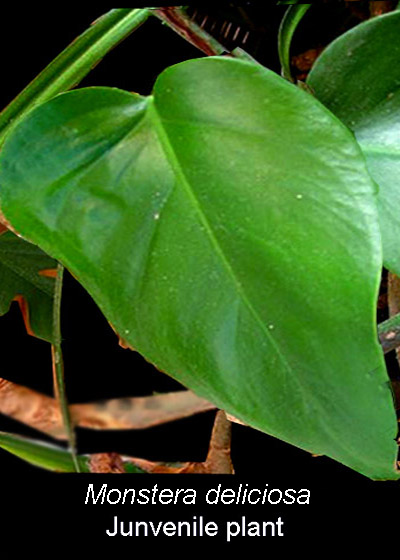 I've known
the name of the large leaf Monstera deliciosa, which
scientifically is only a distant Philodendron relative but not
a
Philodendron, for many years. It is likely the first
scientific plant name I ever learned as a result
of specimens being found all over South Florida.
I've known
the name of the large leaf Monstera deliciosa, which
scientifically is only a distant Philodendron relative but not
a
Philodendron, for many years. It is likely the first
scientific plant name I ever learned as a result
of specimens being found all over South Florida.
But then the
internet began to offer another name: "Philodendron pertusum"
and the internet has totally convinced many average collectors the little green (sometimes artificially variegated) plant is a totally different and new plant!
The so called Philodendron pertusum" is nothing more than a
juvenile form of Monstera deliciosa but no amount of
scientific proof is ever going to convince many of those collectors of that fact. Many collectors just love to
believe what they read on internet plant discussion groups and
will continue to believe their little juvenile "Philodendron"
can't possibly be the same plant as the big leaf plant with
holes in their leaves known to science as Monstera deliciosa.
The recent movie
Avatar by famed director James Cameron contains a now famous
line which I absolutely love,
"We have
tried to teach the sky people but it is hard to fill a cup that
is already full." I
have now personally all but given up on those few collectors who
consider
bits and fragments of information on the internet plant chat
sites to be "expert"
information. If you have already accepted the plant to
the right above is a Philodendron and not a juvenile Monstera
deliciosa you will likely find the rest of the photos and
information on this page of no use. The photo to the right
(above) is in fact the juvenile leaf of Monstera deliciosa.
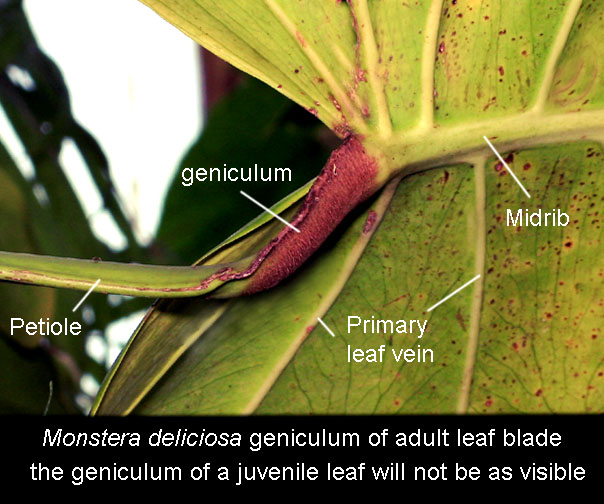 If
you are willing to do a bit of examination I can offer a few
simple ways to determine if your plant is likely to be
Monstera deliciosa or another Monstera species. Take
your specimen and locate the largest leaf on the plant.
Look
directly beneath the blade at the point where the leaf
joins the petiole (the stalk that supports the leaf). Can
you see or
feel a slight "bulge" or "bump"? Monstera
possess a geniculum as do Anthurium and other genera, but
Philodendron species do not. The geniculum allows the
leaves to rotate to some degree in order to gather more light.
Look at the geniculum and you are likely to see ridges or
grooves beginning to develop. These are very common on
larger leaves
but may be difficult to find on an extremely
juvenile plant.
If
you are willing to do a bit of examination I can offer a few
simple ways to determine if your plant is likely to be
Monstera deliciosa or another Monstera species. Take
your specimen and locate the largest leaf on the plant.
Look
directly beneath the blade at the point where the leaf
joins the petiole (the stalk that supports the leaf). Can
you see or
feel a slight "bulge" or "bump"? Monstera
possess a geniculum as do Anthurium and other genera, but
Philodendron species do not. The geniculum allows the
leaves to rotate to some degree in order to gather more light.
Look at the geniculum and you are likely to see ridges or
grooves beginning to develop. These are very common on
larger leaves
but may be difficult to find on an extremely
juvenile plant.
Now look at the
other end of the petiole. If you have a leaf that recently
opened you will notice it grew out of an adjacent petiole.
At the base of the petiole that the new leaf emerged from see if
you can find "wings". Those "wings" are petiolar sheaths
and serve the same purpose as a cataphyll on many plants. As Monstera
deliciosa matures it will begin to produce the new leaves
from cataphylls. A
cataphyll is a bract-like modified leaf which surrounds any
newly developing leaf to protect an emerging blade as it
develops.
Now look at the length of
the petiole. Do you see a groove running down the
petiole's upper surface? This groove is known as a sulcus
or the petiole is canaliculate. As the petioles mature they
will begin to flatten near the apex where the petiole joins the
geniculum. This is all the nature of the
ontogeny or natural changes of the species. Just like
people change as they mature, plants change as they grow.
If you find a
geniculum, petiolar sheaths, and the canaliculate petiole the
chances are extremely high you have a juvenile Monstera
deliciosa or a related species of Monstera. These
features combined with the leaf margins beginning to cut into
the blade are all but a dead giveaway. There are
many other differences in a Monstera and a
Philodendron but you will have to wait for the plant to
mature to see them all. Still, if I quoted all this
information verbatim from a scientific text some now reading
this will go back to their internet plant chat forum and declare
all this information to be invalid. It is just the nature
of collecting plants and the tendency to believe what you read
on the internet.
The juvenile form of
Monstera deliciosa looks nothing like the adult form and
only a few years of additional growth will ever teach most of
the growers that have already accepted intenet fiction the facts.
Only time can force that change. The reason is a common
thing that happens to many plants, especially those that are
tropical, known as ontogeny and natural variation which will be
explained later.
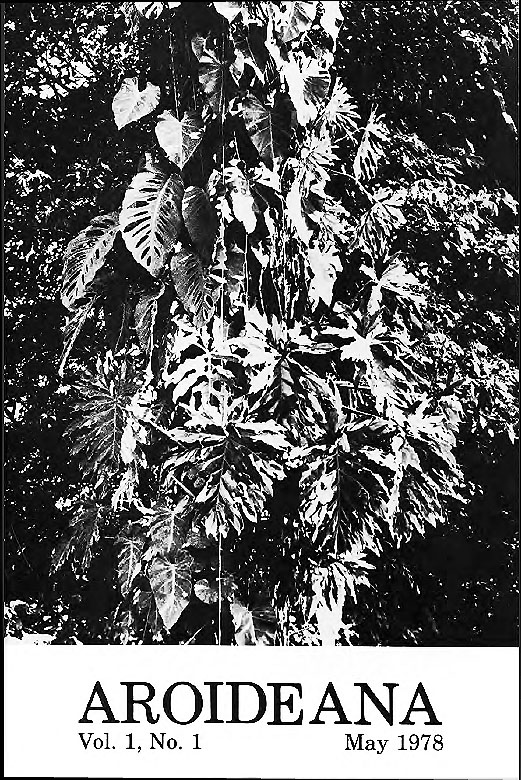 It appears the
name Monstera
deliciosa was just too
common a name for one large plant cultivation company so they
dug out an inaccurate name in order to promote their "new"
plant. The name Philodendron pertusum (L.) K.
Koch & C.D. BouchÚ is a published scientific name but was
incorrectly published and is now a synonym for Monstera
deliciosa which is not a Philodendron species.
It appears the
name Monstera
deliciosa was just too
common a name for one large plant cultivation company so they
dug out an inaccurate name in order to promote their "new"
plant. The name Philodendron pertusum (L.) K.
Koch & C.D. BouchÚ is a published scientific name but was
incorrectly published and is now a synonym for Monstera
deliciosa which is not a Philodendron species.
Despite commonly
held belief, the species Monstera deliciosa is a tree climber,
just look at the photos on this page.
The large
leaf favorite
with holes in it's leaves resembling Swiss cheese is very easy
to grow and will live well even as a
house plant or in the yard
if you are fortunate enough to live in a semi-tropical climate.
To a scientist those "holes" are known as fenestrations from the
Latin word for window. But if you elect to grow this plant in a
pot, give it a big one with porous soil that does not
remain soggy!
Be aware this species is variable and not every leaf of every plant will look exactly
the same! As a result, expect to see several different leaf
shapes and sizes. A link which better explains variation
within plant species is located near the bottom of this page.
Monstera deliciosa was the very first plant
ever profiled in the International Aroid Society journal
Aroideana, Volume 1, number 1, in May, 1978. A
subscription to Aroideana is included with your annual
membership. For
information on joining the International Aroid Society (IAS),
Join the IAS
The species
Monstera deliciosa originates in Mexico in the state of Oaxaca.
The species is not as commonly seen in the wild as in cultivation.
M, deliciosa is
often found growing near water at elevations ranging from
1,525 to 2,135 meters (5,000 to 7,000 feet) and has heavily coriaceous (leathery) leaves.
It is native
primarily to the
forests of both
Oaxaca and Veracruz but is also found south
through Central America into Ecuador and Peru. Some of the specimens found in
Central America have smaller leaf blades and include Monstera deliciosa var. borsigiana (Engl.)
and Monstera deliciosa var. sierrana. The
shortened form of variation is "var".
Only
when mature does the plant produce the cream colored spathe. All
aroids, including Monstera deliciosa, are
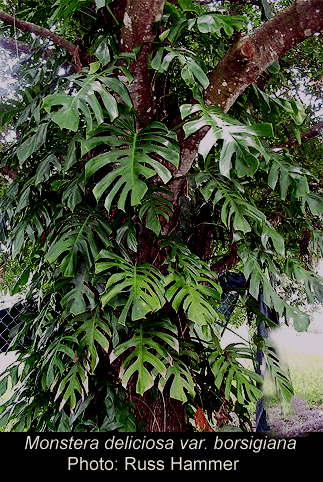 members of the
family Araceae and reproduce by developing a spathe and spadix
which many people consider to be a large "flower" . The true flowers, are tiny and grow on the spadix at the
center which resembles a long, thin pine cone.
The spadix is a spike on a thickened fleshy axis which can
produce tiny flowers.
members of the
family Araceae and reproduce by developing a spathe and spadix
which many people consider to be a large "flower" . The true flowers, are tiny and grow on the spadix at the
center which resembles a long, thin pine cone.
The spadix is a spike on a thickened fleshy axis which can
produce tiny flowers.
Monstera differ from Philodendron species since all
Monstera produce perfect flowers containing both male and
female organs while Philodendron produce imperfect flowers
containing only a single sex. When an
Monstera is "in flower" the reference is to the tiny flowers
containing both pefect male and female sexual parts that grow on the spadix
at the center of the inflorescence. To help prevent self pollination nature has
designed the female flowers to be receptive before the male portion of
the flower
produce their pollen so in most cases an insect must bring pollen from
another plant. For more information on the sexual reproduction of
any aroid click the pollination link below. However,
self pollination is possible.
The spathe
(right) measures approximately 25.5cm (10 inches) and the spadix at the
center measures up to approximately 17.75cm (7 inches) before
the fruit begins to develop. Once pollinated, the spadix
begins to swell and
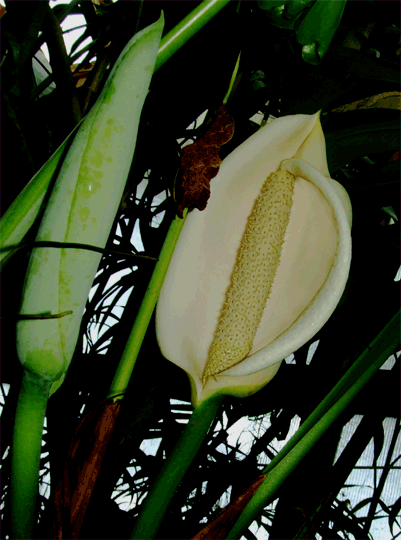 substantially increases its own size. The fruit is delicious, and
quite safe to eat once ripe (yellow). That fruit is how the
species received the name "deliciosa", or delicious
and will eventually contains seeds. Just make
sure the fruit has turned yellow before eating.
substantially increases its own size. The fruit is delicious, and
quite safe to eat once ripe (yellow). That fruit is how the
species received the name "deliciosa", or delicious
and will eventually contains seeds. Just make
sure the fruit has turned yellow before eating.
In all
its natural range the fruit is commonly consumed. The ripening
process takes close to 10 months from the time the spathe is
first seen. The fruit tastes very much like pineapple mixed with
strawberry. Before the fruit ripens the spathe will
completely fall away. The spadix at the left
(below) is
not ripe and will be ready to eat in several more months from
the date of this photo (7/08). This spadix already
stands 24cm (9.5 inches) above the peduncle which is at the base of
the spadix. The photo (below, ) shows the spadix
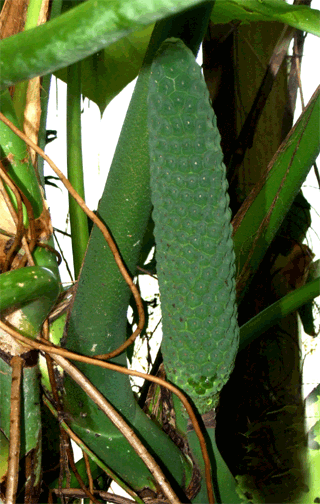 as the fruit is just beginning to ripen. To achieve
maximum flavor the spadix should change color to yellow.
as the fruit is just beginning to ripen. To achieve
maximum flavor the spadix should change color to yellow.
If you have read on
the internet that all Philodendron and Monstera
sp. and their fruit are poisonous, I am proof this one is not.
My family eats every fruit that
matures on our plants. Some
scientific sources report there is as much of the chemical
compound that is supposedly "poisonous" in spinach as in this
plant. Just don't try to eat the leaves! However, if
you or a family member is known to be sensitive to calcium
oxalate crystals, caution should be used. It is possible
to cut the peduncle which is the support of the spadix just
prior to ripening and allow it to fully ripen in a controlled
situation. Aroid expert Leland Miyano offers this
information and a caution,
"Pick
or buy a mature fruit. It should be green and firm and there
should be a slight separation between the scales near the
peduncle. Wrap the fruit in a brown paper bag or aluminum foil.
Do not attempt to eat it until the little green plates or scales
of the rind begin to fall off. When the remaining plates are
very easy to remove, it can be eaten. The inedible core should
just pull away.
Some people are sensitive to the calcium oxalate,
even in fully ripe fruit. If you have never eaten Monstera
deliciosa or are sensitive...caution is advised."
I n many aroid species the
leaves are very distasteful and may be harmful if eaten. Many
aroid species are eaten once
properly prepared. Unless
you know how to properly prepare an aroid, consumption is is not advisable.
However, many
including Alocasia and Colocasia species have been eaten by ethnic communities around the globe
for at least 10,000 years. This link explains some of the myths
relating to calcium oxalate crystals:
Calcium oxalate crystals
n many aroid species the
leaves are very distasteful and may be harmful if eaten. Many
aroid species are eaten once
properly prepared. Unless
you know how to properly prepare an aroid, consumption is is not advisable.
However, many
including Alocasia and Colocasia species have been eaten by ethnic communities around the globe
for at least 10,000 years. This link explains some of the myths
relating to calcium oxalate crystals:
Calcium oxalate crystals
Although found on
the internet as
Philodendron pertusum, that name is not applicable
within science to this species. The name appears to be
poor copy of Monstera pertusam, a synonym of
Monstera adansonii,
(click the highlighted link to see that plant).
Monstera adansonii is not the same as
Monstera deliciosa. Monstera pertusum is also a
non-scientific name, simply one someone made up. The scientific
name Monstera pertusa can be located on TROPICOS (a
service of the Missouri Botanical Garden) but is not associated
with the species Monstera deliciosa.
So how should you
grow aroids such as Monstera deliciosa? If you
could visit a rain forest you would quickly learn the soil is
composed of leaf litter, decaying wood, compost, animal
droppings and the charcoal left behind when a part of the forest
burns. If we'll just listen to Mother Nature we can all make our
plants grow as they do in nature. That is precisely what I
attempt to explain when I recommend mixing soil, not just buying
a bag at the store. Over time we've arrived at a soil mixture
for most of our aroid species which duplicates the rain forest.
We use this mixture on the advice of the aroid keepers at the
Missouri Botanical Garden in St. Louis. The goal of this mix is
to allow the roots to freely find places to extend and grow
without constantly finding wet places where they will rot. This
mix will remain damp but drain quickly and as you can see from
the photo above will make the plants thrive.
Rather than using a rich, soggy soil and watering only once a
week (or less), use a soil that holds moisture well but
drains
quickly. With the help of botanical garden researchers we've
developed a soil mixture for most of our
rain forest
species that
works great. People who visit our artificial rain forest are
often amazed at the size of many of our specimens that grow much
faster and larger than they often do in a home.
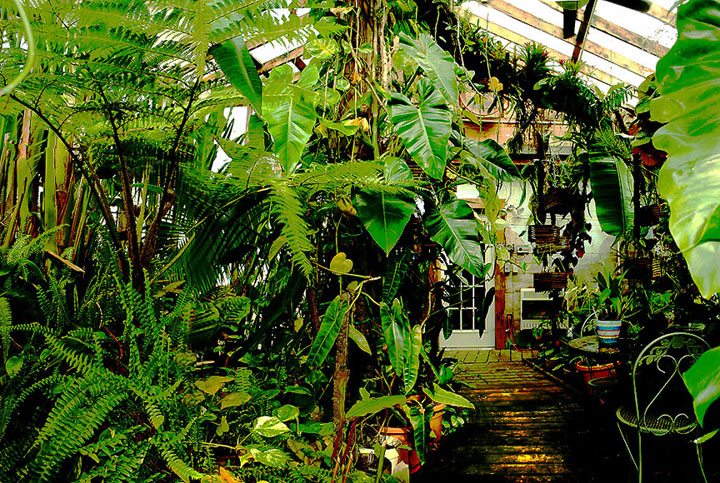 The exact mixture is not critical but we use a
soil mixture composed of approximately
30% soil,
20% peat, 40% orchid bark with charcoal , 10% Perlite and some finely
cut and shredded sphagnum moss works well.
We also make our own
compost and add it in place of some of the peat and bark
when available.
We often add extra
hardwood or aquarium charcoal to
help purify the soil
and sometimes volcanic rock. If you are concerned
about your soil remaining wet just add more orchid mix, cypress
mulch, Perlite and sphagnum moss. Never use a pot that
cannot drain!
The exact mixture is not critical but we use a
soil mixture composed of approximately
30% soil,
20% peat, 40% orchid bark with charcoal , 10% Perlite and some finely
cut and shredded sphagnum moss works well.
We also make our own
compost and add it in place of some of the peat and bark
when available.
We often add extra
hardwood or aquarium charcoal to
help purify the soil
and sometimes volcanic rock. If you are concerned
about your soil remaining wet just add more orchid mix, cypress
mulch, Perlite and sphagnum moss. Never use a pot that
cannot drain!
We grow many
different aroid species in this basic mixture and some of our
specimens have reached their adult or near
adult size and
regularly produce a spathe and spadix (inflorescence). The goal
of our mixture is to cause the water to flow through the soil
quickly, remain slightly damp, but never soggy. The roots of our
plants attach to the bark just as they
do
in nature on the side of a tree. Most growers call a mix similar
to the one we use a "jungle mix".

Some collectors also
confuse Rhaphidophora
species and believe they are a
small form of Monstera delicosa. Aroid
botanist P.C. "Pete" Boyce, who teaches and works in the
Malaysian rain
forests near Singapore, offered this information on the aroid
forum Aroid l regarding the
name Rhaphidophora pertusa, an Asian species with a
similar leaf appearance to Monstera delicosa, "most
plants in cultivation labeled as R. pertusa are actually R.
tetrasperma. In fact, I have very seldom seen true R. pertusa
cultivated and never seen it in European or US collections."
(See photo right) You can see Rhaphidophora tetrasperma
here:
 The leaf size of
Monstera deliciosa can reach nearly 90cm (3
feet) but can be controlled by simply not watering the
plant as often. The variations of this species may be
somewhat smaller in size. Some websites claim the leaves can grow to 150cm
(5 feet), but no scientific documentation to prove that size
leaf blade can
be found. If you like big leaves as much as I, then pour on the
water! The plant grows in nature close to water and water
tends to increase the plant's size.
The leaf size of
Monstera deliciosa can reach nearly 90cm (3
feet) but can be controlled by simply not watering the
plant as often. The variations of this species may be
somewhat smaller in size. Some websites claim the leaves can grow to 150cm
(5 feet), but no scientific documentation to prove that size
leaf blade can
be found. If you like big leaves as much as I, then pour on the
water! The plant grows in nature close to water and water
tends to increase the plant's size.
The
species Monstera delicosa was first published
to science in Videnskabelige Meddelelser fra Dansk
Naturhistorisk Forening i Kj°benhavn in 1849. An
epiphyte (ep-a-FIT), the
species is quite capable of climbing a tree despite internet
posts which claim this species is not a climber. The
scientific description points out the species is truly epiphytic
which means it can grow upon another plant such as a tree. The leaves emerge
from a petiolar sheath.
Monstera deliciosa
has proven to be
variable and not every leaf of every plant will look exactly alike!
Some sources estimate as many as one out of every eight plant species on
earth have natural variations. In addition to variability
juvenile specimens undergo an enormous amount of change in exactly
the same way as any child changes from a baby to age two. Then
the child continues to change from age two to the time they become a
teenager and finally an adult.. Those changes are known as
ontogeny and it happens all the time in both humans and plants.
Leaves do not always look the same from one specimen to another. This link will give you an easy to understand explanation of the
natural variation within plant species using many photographs.
If you don't care to read the text, at least look at the photos.
You will be very surprised:
Natural Variation
More information about growing the related
family Philodendron can be found here.
Curious about calcium oxalate crystals? That is the compound
many websites claim is a "deadly poison". People in
the Caribbean and Polynesia eat it all the time, and so do
vegetarians! Click this link for
more information.
Want to learn more
about aroids?
Join the
International Aroid Society:
http://www.exoticrainforest.com/Join%20IAS.html
![]()
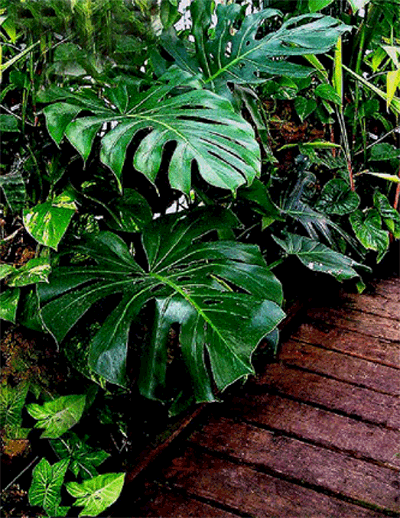
 I've known
the name of the large leaf Monstera deliciosa, which
scientifically is only a distant Philodendron relative but not
a
Philodendron, for many years. It is likely the first
scientific plant name I ever learned as a result
of specimens being found all over South Florida.
I've known
the name of the large leaf Monstera deliciosa, which
scientifically is only a distant Philodendron relative but not
a
Philodendron, for many years. It is likely the first
scientific plant name I ever learned as a result
of specimens being found all over South Florida.  If
you are willing to do a bit of examination I can offer a few
simple ways to determine if your plant is likely to be
Monstera deliciosa or another Monstera species. Take
your specimen and locate the largest leaf on the plant.
Look
directly beneath the blade at the point where the leaf
joins the petiole (the stalk that supports the leaf). Can
you see or
feel a slight "bulge" or "bump"? Monstera
possess a geniculum as do Anthurium and other genera, but
Philodendron species do not. The geniculum allows the
leaves to rotate to some degree in order to gather more light.
Look at the geniculum and you are likely to see ridges or
grooves beginning to develop. These are very common on
larger leaves
but may be difficult to find on an extremely
juvenile plant.
If
you are willing to do a bit of examination I can offer a few
simple ways to determine if your plant is likely to be
Monstera deliciosa or another Monstera species. Take
your specimen and locate the largest leaf on the plant.
Look
directly beneath the blade at the point where the leaf
joins the petiole (the stalk that supports the leaf). Can
you see or
feel a slight "bulge" or "bump"? Monstera
possess a geniculum as do Anthurium and other genera, but
Philodendron species do not. The geniculum allows the
leaves to rotate to some degree in order to gather more light.
Look at the geniculum and you are likely to see ridges or
grooves beginning to develop. These are very common on
larger leaves
but may be difficult to find on an extremely
juvenile plant. It appears the
name Monstera
deliciosa was just too
common a name for one large plant cultivation company so they
dug out an inaccurate name in order to promote their "new"
plant. The name Philodendron pertusum (L.) K.
Koch & C.D. BouchÚ is a published scientific name but was
incorrectly published and is now a synonym for Monstera
deliciosa which is not a Philodendron species.
It appears the
name Monstera
deliciosa was just too
common a name for one large plant cultivation company so they
dug out an inaccurate name in order to promote their "new"
plant. The name Philodendron pertusum (L.) K.
Koch & C.D. BouchÚ is a published scientific name but was
incorrectly published and is now a synonym for Monstera
deliciosa which is not a Philodendron species. members of the
family Araceae and reproduce by developing a spathe and spadix
which many people consider to be a large "flower" . The true flowers, are tiny and grow on the spadix at the
center which resembles a long, thin pine cone.
The spadix is a spike on a thickened fleshy axis which can
produce tiny flowers.
members of the
family Araceae and reproduce by developing a spathe and spadix
which many people consider to be a large "flower" . The true flowers, are tiny and grow on the spadix at the
center which resembles a long, thin pine cone.
The spadix is a spike on a thickened fleshy axis which can
produce tiny flowers. substantially increases its own size. The fruit is delicious, and
quite safe to eat once ripe (yellow). That fruit is how the
species received the name "deliciosa", or delicious
and will eventually contains seeds. Just make
sure the fruit has turned yellow before eating.
substantially increases its own size. The fruit is delicious, and
quite safe to eat once ripe (yellow). That fruit is how the
species received the name "deliciosa", or delicious
and will eventually contains seeds. Just make
sure the fruit has turned yellow before eating.  as the fruit is just beginning to ripen. To achieve
maximum flavor the spadix should change color to yellow.
as the fruit is just beginning to ripen. To achieve
maximum flavor the spadix should change color to yellow. n many aroid species the
leaves are very distasteful and may be harmful if eaten. Many
aroid species are eaten once
properly prepared. Unless
you know how to properly prepare an aroid, consumption is is not advisable.
However, many
including Alocasia and Colocasia species have been eaten by ethnic communities around the globe
for at least 10,000 years. This link explains some of the myths
relating to calcium oxalate crystals:
Calcium oxalate crystals
n many aroid species the
leaves are very distasteful and may be harmful if eaten. Many
aroid species are eaten once
properly prepared. Unless
you know how to properly prepare an aroid, consumption is is not advisable.
However, many
including Alocasia and Colocasia species have been eaten by ethnic communities around the globe
for at least 10,000 years. This link explains some of the myths
relating to calcium oxalate crystals:
Calcium oxalate crystals The exact mixture is not critical but we use a
soil mixture composed of approximately
30% soil,
20% peat, 40% orchid bark with charcoal , 10% Perlite and some finely
cut and shredded sphagnum moss works well.
We also make our own
compost and add it in place of some of the peat and bark
when available.
We often add extra
hardwood or aquarium charcoal to
help purify the soil
and sometimes volcanic rock. If you are concerned
about your soil remaining wet just add more orchid mix, cypress
mulch, Perlite and sphagnum moss. Never use a pot that
cannot drain!
The exact mixture is not critical but we use a
soil mixture composed of approximately
30% soil,
20% peat, 40% orchid bark with charcoal , 10% Perlite and some finely
cut and shredded sphagnum moss works well.
We also make our own
compost and add it in place of some of the peat and bark
when available.
We often add extra
hardwood or aquarium charcoal to
help purify the soil
and sometimes volcanic rock. If you are concerned
about your soil remaining wet just add more orchid mix, cypress
mulch, Perlite and sphagnum moss. Never use a pot that
cannot drain!
 The leaf size of
Monstera deliciosa can reach nearly 90cm (3
feet) but can be controlled by simply not watering the
plant as often. The variations of this species may be
somewhat smaller in size. Some websites claim the leaves can grow to 150cm
(5 feet), but no scientific documentation to prove that size
leaf blade can
be found. If you like big leaves as much as I, then pour on the
water! The plant grows in nature close to water and water
tends to increase the plant's size.
The leaf size of
Monstera deliciosa can reach nearly 90cm (3
feet) but can be controlled by simply not watering the
plant as often. The variations of this species may be
somewhat smaller in size. Some websites claim the leaves can grow to 150cm
(5 feet), but no scientific documentation to prove that size
leaf blade can
be found. If you like big leaves as much as I, then pour on the
water! The plant grows in nature close to water and water
tends to increase the plant's size.